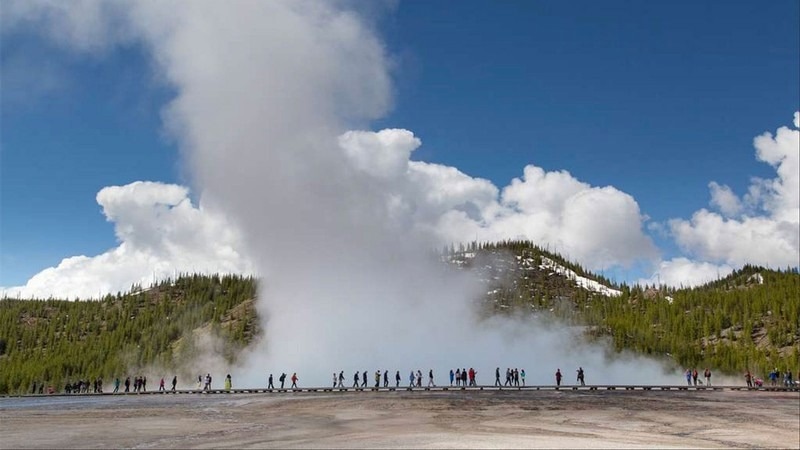People rely on natural ecosystems of trees, grasses, and shrubs to capture carbon from the atmosphere and store it underground, slowing the descent toward climate change disaster. Ironically, these same protected areas are also popular tourist destinations due to their scenic beauty.

Visitors walk the boardwalk at the Grand Prismatic Spring in Yellowstone National Park. Image Credit: National Park Service
Recent studies by the Quinney College of Natural Resources and the Institute of Outdoor Recreation and Tourism have focused on Yellowstone National Park as a case study to measure the excess carbon emissions contributed by visitors from around the globe each year, directly attributable to their visits to the park.
Emily Wilkins and Jordan Smith of the Department of Environment and Society, together with colleagues, used available data to calculate the carbon emissions created by one year of tourist visits to Yellowstone National Park, a popular site with over 4 million people each year.
The researchers estimated that recreational visits to Yellowstone National Park generate slightly more than one megaton of carbon emissions annually, with an average of 479 kilograms of emissions attributable to each visitor. This amount is roughly equivalent to the weight of a grand piano.
The majority of these emissions are generated even before a visitor enters the park gates. Travel to and from the park's entrance is responsible for nearly 90 percent of the total emissions. Another 5 percent results from visitors traveling within the park, and 4 percent originates from overnight stays. Only 1 percent of the total emissions are attributed to park operations, including visitor centers, museums, shops, and restaurants.
Flights account for little over one-third of all visitors to Yellowstone, yet those specific flights are responsible for an astounding 72 % of all emissions related to out-of-park travel.
As the tourism industry explores strategies to reduce their carbon impact, this could be low-hanging fruit. Future campaigns to encourage a greater proportion of visitors from nearby locations rather than Europe or Asia, or encouraging driving over flying, have potential for big impacts on reducing these emission numbers.
Emily Wilkins, Research Social Scientist, US Geological Survey
However, Yellowstone National Park's carbon accounting still seems to be in the black.
Interestingly, ecosystems within the park boundary pull around 1.5 megatons of carbon from the atmosphere each yea. So, even accounting for the significant impact of tourism, there is a net benefit in the system as a carbon sink.
Jordan Smith, Professor, Department of Environment and Society, Utah State University
This is almost certainly not the case for smaller parks with high visitation numbers, he said.
According to Smith, this novel approach to calculating the carbon impact of tourism in national parks is intended to be scalable for use in other parks and protected areas, allowing decision-makers to assess the efficiency of various emission reduction plans.
Tourism is a major contributor to global carbon emissions. According to one estimate, tourism accounts for 8 % of yearly worldwide carbon emissions, with the United States having the dubious distinction of having the world’s largest total tourism carbon footprint, and that number is anticipated to rise.
It is important to note that this research was not a comprehensive policy analysis, according to the authors. Not all costs and benefits associated with ecotourism were examined. For instance, despite tourism's notable contribution to global carbon emissions, the positive encounters and educational opportunities provided by parks such as Yellowstone could foster indirect environmental advantages. These include the promotion of environmentally friendly practices among visitors once they return home.
Wilkins concluded, “We really need more research on both the effect of tourism on climate change, and the effect of climate change on tourism. These topics both have major economic and environmental repercussions. Managers and decision makers need a more complete perspective for how tourism to parks is contributing to a vulnerable global climate system.”
Journal Reference:
Wilkins, E. J., et. al. (2024) Quantifying and evaluating strategies to decrease carbon dioxide emissions generated from tourism to Yellowstone National Park. PLOS Climate. doi:10.1371/journal.pclm.0000391